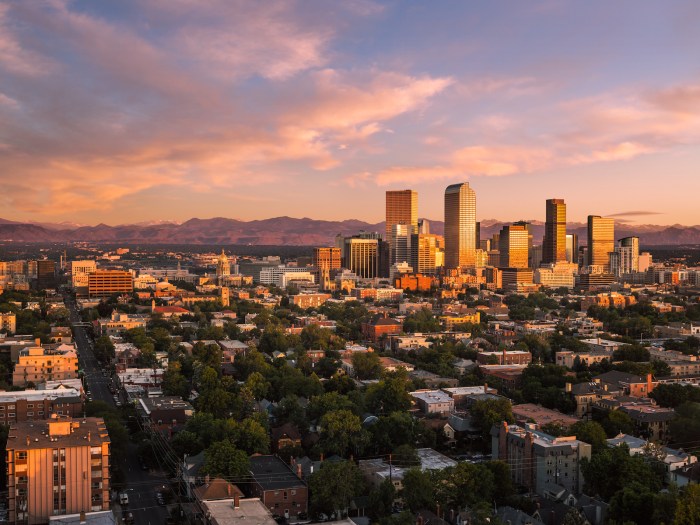About 5280 ft for denver nyt – Unveiling the captivating story of Denver’s elevation at about 5280 ft, this comprehensive exploration delves into the significance of its “Mile High City” status, its historical and cultural impact, and its practical implications for residents and visitors alike.
From its historical anecdotes to its influence on daily life, Denver’s altitude has shaped its unique identity and continues to fascinate those who encounter it.
Denver’s Elevation

Denver, the capital of Colorado, is located at an elevation of approximately 5,280 feet (1,609 meters) above sea level. This high altitude has earned Denver the nickname “The Mile High City.”
Significance of the Mile High City
Denver’s elevation has had a significant impact on the city’s development and culture. The high altitude has led to a number of unique characteristics, including:
- Lower air pressure:The lower air pressure at high altitudes means that there is less oxygen available to breathe. This can lead to altitude sickness in some people, but it can also have beneficial effects, such as reducing the risk of heart disease and stroke.
- Increased solar radiation:The thinner atmosphere at high altitudes allows more ultraviolet (UV) radiation from the sun to reach the Earth’s surface. This can increase the risk of sunburn and skin cancer, but it can also be beneficial for people with certain medical conditions, such as psoriasis.
- Drier climate:The high altitude also leads to a drier climate, with less precipitation than at lower elevations. This can make the air feel more comfortable, but it can also lead to wildfires and other dry-weather hazards.
Historical Context of Denver’s Elevation

Denver’s high altitude has played a significant role in shaping its history and development.The city’s elevation has influenced its climate, making it prone to extreme weather conditions such as hail, thunderstorms, and blizzards. This has necessitated the development of specialized infrastructure and building techniques to withstand these challenges.
Denver’s Mile High City Moniker
Denver’s elevation has earned it the nickname “Mile High City.” This moniker has become synonymous with the city’s identity and is reflected in various aspects of its culture, including its sports teams and landmarks.
The Great Plains and Denver’s Elevation
Denver’s location at the edge of the Great Plains has also been influenced by its elevation. The city’s high altitude creates a natural barrier between the plains and the Rocky Mountains, which has historically affected trade and transportation routes.
Impact on Daily Life

Denver’s high elevation has tangible effects on the daily lives of residents and visitors. The altitude significantly impacts oxygen levels, physical activity, and overall well-being.
At Denver’s elevation, the air is thinner, resulting in lower oxygen levels. This can lead to shortness of breath, fatigue, and headaches, especially during strenuous activities. Visitors may experience altitude sickness, which can cause nausea, vomiting, and headaches. To mitigate these effects, it is recommended to gradually ascend to higher altitudes, stay hydrated, and avoid strenuous activity immediately upon arrival.
Physical Activity
The lower oxygen levels at Denver’s elevation can affect physical performance. Activities such as running, cycling, and hiking may feel more challenging due to reduced oxygen intake. However, over time, the body adapts to the altitude, and physical fitness can improve.
Overall Well-being
Living at a high elevation can have positive and negative effects on overall well-being. The lower oxygen levels can improve sleep quality, reduce the risk of certain cardiovascular diseases, and increase red blood cell production. However, it can also lead to dehydration, dry skin, and increased susceptibility to respiratory infections.
At about 5280 ft above sea level, Denver is known for its stunning views and vibrant culture. However, beyond the surface lies a deeper narrative, a story that echoes the sentiment expressed in “My Life is My Foe’s Debt” ( my life is my foe’s debt ). The city’s altitude mirrors the weight of its past, the struggles and triumphs that have shaped its present.
Yet, like the majestic mountains that surround it, Denver continues to rise, its spirit unyielding, its future as boundless as the sky above its towering peaks.
Cultural Significance

Denver’s elevation has significantly influenced its cultural identity and sense of place. Its unique altitude has inspired art, literature, and local traditions, shaping the city’s distinct character.
Art and Literature, About 5280 ft for denver nyt
Denver’s elevation has provided artists and writers with a unique perspective and subject matter. The city’s expansive views and stunning mountain vistas have been captured in countless paintings, sculptures, and photographs. Literary works set in Denver often explore themes of altitude and its impact on human experience.
Local Traditions
The altitude has also influenced Denver’s local traditions. For instance, the city’s annual “Mile High City Marathon” celebrates its unique elevation. Denverites also take pride in their “mile-high” status, which is reflected in the city’s nickname and local slang.
Clarifying Questions: About 5280 Ft For Denver Nyt
How does Denver’s elevation affect daily life?
The high altitude can impact oxygen levels, physical activity, and overall well-being, requiring some adjustment for residents and visitors.
What is the historical significance of Denver’s elevation?
Denver’s elevation has played a role in its development and culture, influencing everything from its nickname to its economic growth.
What are the economic advantages of Denver’s elevation?
The city’s high altitude can provide advantages for certain industries, such as aerospace and telecommunications.
